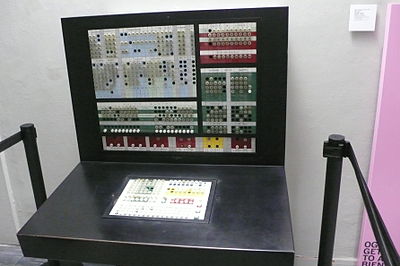- Olivetti Elea
-
The Elea 9003 is one of a series of mainframe computers Olivetti developed starting in the late 1950s. The system, made entirely with transistors for high performance, was conceived, designed and developed by a small group of researchers led by Mario Tchou (1924–1961). It was announced only a few months after the release of Siemens 2002 and several months before the first IBM transistorized computer. The acronym ELEA stood for ELaboratore Elettronico Aritmetico (Arithmetical Electronic Computer) and was chosen with reference to the ancient Greek colony of Elea, home of the Eleatic school of philosophy. About forty units were placed with customers, although Olivetti left the mainframe business only a few years after releasing the 9003.[1]
Contents
Generations
The Elea 9000 had three generations:
Elea 9001 (Machine Zero) prototype was made with vacuum tubes, but used germanium transistors for the tape drive system. The system was completed in spring 1957 and was later sent to Ivrea where for six years it controlled the Olivetti production warehouses. The machine was a prototype.
Elea 9002 (Machine 1V) was a prototype with printed circuits and optimized design, much faster than its predecessor and utilizing silicon transistors for the management of tape drives. The machine was used as a test for the transistors, to establish if they were more reliable and economic than vacuum tubes.
Elea 9003 (1T machine), designed entirely in discrete (Diode-transistor logic), was the first fully transistorized commercial computer. With industrial design by Ettore Sottsass, it was leased to about 40 individual customers, of which the first (Elea 9003/01) was installed at the textile company Marzotto and second (Elea 9003/02) to Monte dei Paschi di Siena. Later this unit was donated for educational purposes. Other mainframes were leased to insurance companies and energy companies.
The Olivetti computers competed directly with foreign manufacturers such as IBM and Ferranti, but received no special consideration from the Italian government. Typical applications were payroll, inventory and accounting.
Features
The computing power (approximately 8 to 10,000 instructions per second) was higher than that of competitors for several years. Uptime - as with all computers of the time - was less than 50%, especially in the tape device. This meant the computer was available for productive work only part of the day, and then returned to technicians for maintenance.
The need to obtain 300,000 highly reliable transistors and diodes for each computer, convinced Adriano Olivetti to build a foundry called SGS in cooperation with the company Telettra . SGS (Società Generale Semiconduttori) later became part of STMicroelectronics.
The computer was equipped with words of 6 bits, plus a parity bit, and word mark bit, with ferrite core memories. Memory was organized in six-bit characters, representing letters, numerals and punctuation. The memory cycle frequency was 100 kHz, with a capacity between 20 and 160 thousand words. The computer did not have an operating system and could be programmed using machine language. The 9003 did not have floating point arithmetic instructions since it was intended for commercial data processing. All instructions were of fixed length (eight characters).
Mass storage for the 9003 was on magnetic tape. Drum, disk and diskette memory was developed but never used at a customer site. Input and output was through punched paper tape or punched cards, and printing on a line printer. A teleprinter was used as operator console to control the machine, with a front panel display for debugging and maintenance.
The industrial design of the system followed Olivetti esthetic and functional standards. Cabinets were about 1 metre high and interconnected by overhead conduits, so the system did not require the raised floor of other mainframe designs. Each cabinet contained a subsystem (processor, memory, tape drives).[2]
Developments
The Elea 6000 series were versions with reduced processing power and cost. They were originally designed for scientific computing with floating-point arithmetic, 4-bit memory width, then later developed for commercial applications (4+4 bits), with a microprogram memory. About 170 units were produced. The Elea 4000, was a later series that was successfully sold by General Electric after it purchased Olivetti's computer interests. Over 40,000 units were sold with the GE model names GE 105, GE-115, GE-125, and GE-130.
The laboratories had also begun to develop a successor to the 9000 series that features a new hardware architecture. The company developed a programming language Palgol,a derivative of ALGOL, and an assembler named Psyche. However, only a limited amount of system and utility software was provided by Olivetti to customers. The death of the engineers Olivetti and Tchou put a brake on laboratory work, which was subsequently sold to General Electric. This marked the end of Elea computers.
Even though the electronics division of Olivetti had been sold off, the knowledge gained was applied in the development of the successful Programma 101 electronic calculator.
References
- ^ Giuditta Parolini Olivetti Elea 9003: Between Scientific Research and Computer Business, in John Impagliazzo (ed) History of computing and education 3 (HCE3): Springer, 2008 ISBN 0387096566, page 37 and ff
- ^ http://www.site.uottawa.ca/~luigi/papers/elea.htm My first two computers
External links
- http://www.scribd.com/doc/16394680/filippazzi08 In Italian
- http://www.isisfermi.it/ITIS/Informatica/Elea9003/tabid/144/language/en-US/Default.aspx Photo and Italian text of the last surviving 9003.
Categories:- 1959 introductions
- Transistorized computers
Wikimedia Foundation. 2010.

